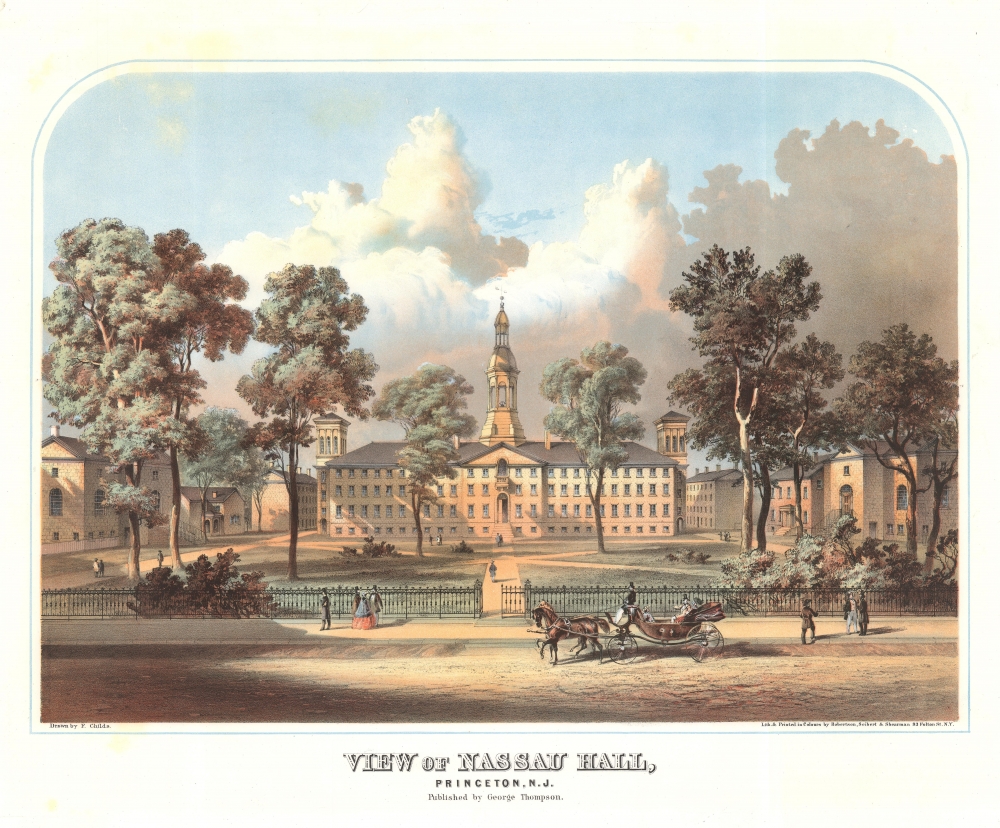This item has been sold, but you can get on the Waitlist to be notified if another example becomes available, or purchase a digital scan.
1860 Childs Chromolithograph View of Nassau Hall, Princeton University
ViewNassauHall-childs-1860
Title
1860 (undated) 16 x 20 in (40.64 x 50.8 cm)
Description
A Closer Look
Princetonians meanders on the pathways while an open carriage pulls up in the foreground. A fence separates the campus grounds from the street, with a spacious lawn in front of the Hall. Other campus buildings are illustrated to either side. Dramatic clouds billow in the background.Nassau Hall
Nassau Hall is the oldest building on Princeton's campus. When it was completed in 1756, it was the largest stone building in the American colonies and was named to honor King William III, 'of the illustrious house of Nassau'. It was damaged by both armies during the American Revolutionary War (1775 - 1783) and served as the U.S. Capitol in 1783 when Princeton was the provisional capital of the United States. Fire destroyed Nassau Hall's interior twice: first in 1802 and again in 1855. During the renovation after the 1855 fire, architect John Notman added towers at either end (evident here in this view). These much-criticized towers were removed in 1905.Chromolithography
Chromolithography, sometimes called oleography, is a color lithographic technique developed in the mid-19th century. The process involved using multiple lithographic stones, one for each color, to yield a rich composite effect. Oftentimes, the process would start with a black basecoat upon which subsequent colors were layered. Some chromolithographs used thirty or more separate lithographic stones to achieve the desired product. Chromolithograph color could also be effectively blended for even more dramatic results. The process became extremely popular in the late 19th and early 20th centuries when it emerged as the dominant method of color printing. The vivid color chromolithography produced made it exceptionally effective for advertising and propaganda imagery.Publication History and Census
This chromolithograph view was drawn by F. Childs, lithographed and printed by Robertson, Siebert, and Shearman, and published by George Thompson c. 1860. We note two cataloged examples: Princeton University Art Museum and the Yale University Art Gallery.Cartographer
Henry Seibert (May 17, 1833 - c. 1902) was a German-American lithographer, financier, and businessman. Born in Lauterbach in the Grand Duchy of Hesse to John and Magdalena Seibert. One of seven children (six sons and a daughter), Henry's father John Seibert was a locksmith and machinist by trade and a man of good practical education. John Seibert, believing that a new life in America would afford his growing family with greater advantages than were available to them in Europe, moved the family to Newburgh, New York in 1837 and, in 1845, relocated to Brooklyn. John Seibert died in 1855. Henry, having immigrated to the United States at the age of 4, was educated in Brooklyn public schools and then learned lithography. He formed the lithography firm of Robertson and Seibert in 1852 with Alexander Robertson, which they built into a successful enterprise. James A. Shearman joined the firm in 1859, creating Robertson, Seibert and Shearman, which lasted for approximately a year, but created numerous beautiful chromolithograph views. When both Robertson and Shearman withdrew from the partnership in 1860, Seibert formed the firm Seibert, Wetzler and Company with this brother Jacob and Ernest Wetzler. The following year the partnership changed to Henry Seibert and Brothers and included Henry, Jacob, and Charles Seibert. The Seibert brothers acquired the lithographic firm of Ferdinand Mayer in the early 1870s and continued to operate it as a separate establishment managed by Jacob Lowenhaupt. Jacob Seibert left to open his own firm in 1878, which means Henry and Charles carried on their business under the imprint Seibert and Brother. Henry Seibert essentially retired from the firm in 1880, although he maintained a financial interest. After retiring, Seibert began to associate himself with other business and financial enterprises, gaining a reputation as a careful and sagacious associate and often operating as both a promoter and a directing manager. He became deeply involved in railroad interests, including the Chicago and Eastern Illinois Railroad, the Queens County and Suburban Railroad, the Brooklyn Union Elevated Railroad, the Brooklyn Heights Railroad, and the Brooklyn Rapid Transit Company. He also served, at one time or another, as director of the Mollenhauer Sugar Refining Company, the Nassau Trust Company, the Lanyon Zinc Company, and the Manhattan Brass Company. He also served as director and vice-president of the Minnesota Iron Company during his lifetime. In 1892, New York Governor Flowers appointed Seibert as a commissioner from the state of New York to the Columbian Exposition in Chicago in 1892. Seibert married Emma J. Bergman with whom he had three sons and a daughter. More by this mapmaker...

